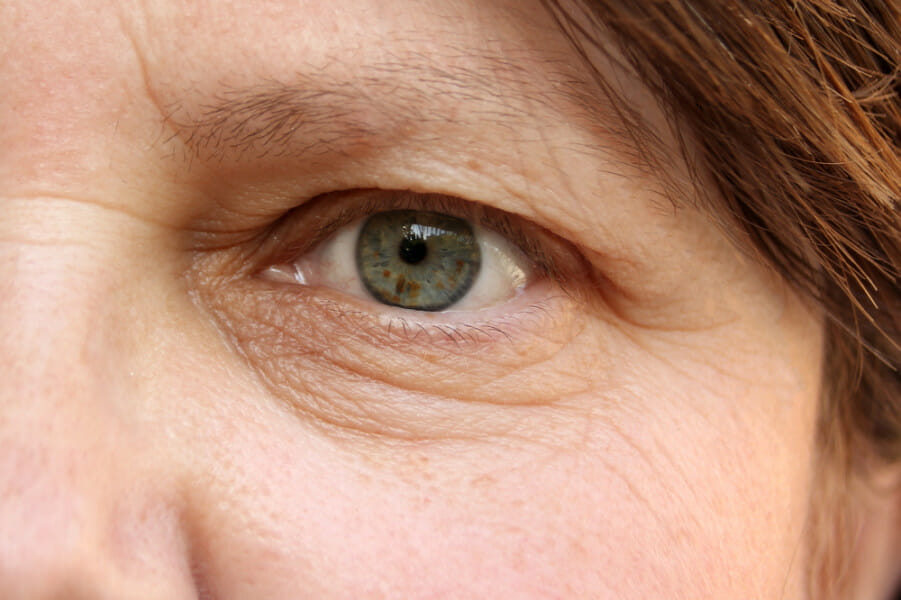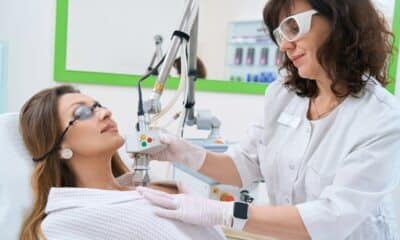All You Should Know About Treating And Preventing Eyelid Wrinkles
I never paid much attention to my eyelids until recently, when I noticed that my eyeshadow wasn’t going on as smoothly as before. Upon closer inspection, I realized that the skin on my eyelids looked and felt looser, with some wrinkles. This mild crepiness had developed gradually as a result of normal skin aging and not taking proper care of the area. It became clear that my negligence had caused this noticeable change, but it also inspired me to take action.
After consulting with several dermatologists for advice on treating my crepiness and mild drooping, I learned that many of us (including myself) tend to neglect this highly sensitive and challenging-to-treat area. Why? Because we often don’t know how to properly care for our eyelid skin. Below, you will find more information about what causes eyelid wrinkles and how to treat them at home, along with recommendations for products and devices to address your biggest concerns about your eyelids.
Why do eyelid wrinkles occur?
While many of us know how to take care of the skin under our eyes, the skin on our eyelids is often overlooked. Despite being similar in composition and susceptibility to problems, the skin around the eyes is 40 percent thinner than the rest of the face, making it much more delicate. As we age, the skin around the eyes can sag and develop wrinkles because it has experienced more years of wear and tear in this delicate area, explains Dr. Dendy Engleman from Shafer Clinic in New York City.
Consider the amount of movement your eyelids experience daily—from blinking to opening and closing expressively while talking, and rubbing them when removing makeup. These repetitive movements are unavoidable and can lead to long-lasting wrinkles that are difficult to reverse if not treated early on.
Just like with my own eyelid wrinkles, one of the main reasons we often neglect our eyelids is that we don’t notice the skin changing until the damage is already done. By the time someone notices the wrinkles, they have become static, meaning they are present without the eyelids moving, explains Dr. Kseniya Kobets from Montefiore Advanced Care in Westchester, New York. Dynamic wrinkles, on the other hand, are wrinkles that appear when someone smiles or squints but are not yet etched in and therefore take years to form.
Common causes of eyelid wrinkles
1. Natural eyelid movement
Continuous movement in the eye area, such as blinking, makes developing eyelid wrinkles almost inevitable without proper care, according to Dr. Kobets.
2. Aging/Loss of collagen
As we age, our bodies naturally produce less collagen, which is responsible for skin elasticity and hydration. The decrease in collagen levels causes the skin to become thinner and less elastic, resulting in wrinkles. The decline in collagen production begins in our 20s and accelerates during menopause due to lower estrogen levels.
3. Sun exposure
Exposure to the sun’s UV rays leads to changes in the skin, including the eyelids. Accumulated sun exposure damages the elastic fibers that keep the skin firm, leading to the development of wrinkles over time.
4. Tugging, rubbing, or pulling at the eyelids
Being too aggressive with the eyes, such as rubbing, pulling, or applying pressure, can stretch the skin around the eyes and cause premature signs of aging, like wrinkles. These actions commonly occur when scratching or rubbing the eyes, applying eye cream improperly, and removing eye makeup aggressively. Repeated movement of the skin can also lead to temporary wrinkles, which can become permanent over time.
5. Dry or dehydrated eyelids
Dry or dehydrated skin exacerbates wrinkles all over the body, including the eyelids. Keeping the eyelids hydrated helps maintain a healthy skin barrier, which protects against external aggressors like sun damage. When the skin around the eyes is dry, it becomes weaker and more prone to harm.
6. Smoking and pollution exposure
Smoking and exposure to environmental pollution can deeply penetrate the skin, including the eyelids, leading to wrinkling over time.
How to treat eyelid wrinkles
1. Be gentle!
When cleansing or touching the eyes, use very light pressure and avoid rubbing or pulling at the delicate eye area, advises Dr. Engleman.
2. Choose gentle and fragrance-free products
Opt for products that minimize irritation and are labeled “fragrance-free,” as the skin on the eyelids is thinner and more delicate.
3. Add an eye cream to your routine
Eye creams provide extra attention and care for the eyelids. They moisturize the skin, stimulate collagen production, reduce fine lines, and improve dark circles. Look for a high-quality eye cream to address your specific concerns.
4. Use a gentle eyelid scrub
Eyelid scrubs are cleansers that sanitize and soothe the skin on the eyelids, particularly if there is irritation and inflammation. They wash away dead skin and bacteria, promoting healthier and stronger eyelids that resist wrinkle formation. However, be cautious not to overuse these scrubs, as they can irritate sensitive skin.
5. Wear sunscreen daily
Apply sunscreen to the eyelids daily to prevent future wrinkles and protect against UV damage.
6. Treat underlying skin issues
Prioritize treating any allergic contact or irritant contact dermatitis in the eyelid area to create an optimal environment for wrinkle treatments. Treating these underlying issues strengthens the skin barrier and enhances the efficacy of topical wrinkle treatments.
7. Try an at-home LED therapy device
Consider using at-home LED red light devices, which are low-risk treatments that can be done for a few minutes a day. Look for devices backed by scientific research and positive customer reviews.
8. Treat yourself to a lymphatic drainage massage
Consider using roller devices or Gua Sha massagers to enhance lymphatic drainage and decrease swelling and inflammation around the eyes. While these tools don’t provide immediate results for fine lines and wrinkles, they improve the long-term health of the skin by increasing circulation.
9. Opt for professional-grade treatments
Aside from at-home treatments and lifestyle changes, professional-grade treatments like low-dose neuromodulators (e.g., Dysport or Botox) can prevent deepening of wrinkles and etched-in lines caused by excessive eyelid movement. Combining early preventative treatments with a gentle skincare routine, at-home LED devices, chemical peels, and lasers can effectively maintain the skin around the eyes.
The best ingredients for eyelid wrinkles
The same skincare ingredients that work well on the rest of your face are also effective for the eyelids, but in lower concentrations. Look for products containing:
- Topical retinoids
- Vitamin C
- Peptides
- Humectants (e.g., glycerin and hyaluronic acid)
- Emollients (e.g., ceramides and dimethicone)
- Antioxidants
Risks of treating eyelid wrinkles with OTC products
Due to the thin and absorbent nature of the skin around the eyes, it is essential to avoid using products with fragrance or high concentrations of retinoids or vitamin C. These ingredients may cause irritation, particularly if the skin barrier is disrupted or if you have active eczema or dermatitis. Additionally, it is advisable to avoid ingredients such as chemical SPF agents, formaldehyde, physical exfoliants, and any products with particles that can scratch the eyelids or enter the eyes.
The best products for treating eyelid wrinkles
Here are some recommended topical products for treating eyelid wrinkles:
Topical products
An award-winning eye cream that moisturizes the skin, stimulates collagen production, and improves texture. It contains hyaluronic acid for hydration and a metal applicator with Cooling Tip Technology for gentle application.
In addition, here are some recommended at-home devices for treating eyelid wrinkles:
At-home devices
An at-home device designed to lift the skin, improve circulation, and tighten the eyelids. With regular use, it can thicken the skin over time and increase collagen production.













